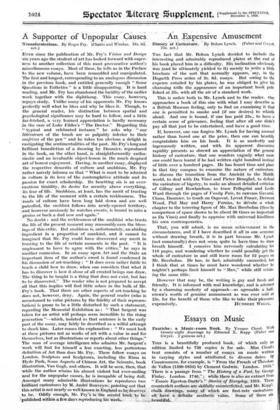-A Supporter of Unpopular auses,
EVER since the publication of Mr. Fry's Vision and Design 'six years ago- the student of art has looked forward with eager- ness to another collection of this most provocative author's miscellaneous essays. Most of these, he tells us in the Preface to the new volume, have been remoulded and- manipulated. The first and longest, corresponding to an analogous discussion in the previous book, and entitled generally enough " Some Questions in Esthetics " is a little disappointing. It is hard reading, and Mr. Fry has abandoned the lucidity of the earlier work together with the diphthong. This essay, however; ',repays study. Unlike many of his opponents Mr. Fry knows -perfectly well what he likes and why he likes it. Though, to the general reader, his distinction between spatial and ;psychological significance may be hard to follow, and a little far-fetched, a very learned appreciation is hardly necessary in the case of Luke Fildes's " The Doctor." Regarding this " typical and celebrated instance " he asks why " our litterateurs of the brush are so palpably inferior to their confreres of the pen " and he takes too obVious a delight in -castigating the sentimentalities of the past. Mr. Fry's long and brilliant benediction of a drawing by Daumier, reproduced in the book, on the other hand, is straightforwardly enthu- siastic and an invaluable object-lesson in the much despised art of honest enjoyment. Having, in another essay, displayed the respective demerits of culture and snobbism, Mr. Fry rather naively informs us that " What is most to be admired -in culture is its love of the contemplative attitude and its passion for exact scholarship. Its besetting sin is an over- cautious timidity, its desire for security above everything, - its fear of life. Snobbism, at least, has the merit of trusting -to the life of the moment with a certain -recklessness. The `,roads of culture have been long laid down and are well ;patrolled, the snobbist follows _into newly-opened territory, and however anxiously he watches events, is bound to miss a genius or back a dud now and again."
No doubt : and the recklessness of the snqbbist who trusts the life of the present moment may reasonably earn the bless- ings of this critic. But snobbism is, unfortunately, an abiding 'ingredient in a proportion of mankind, and it cannot be imagined that Mr. Fry could have discovered any merit in "trusting to the life of certain moments in the past. " It is unpleasant to have to agree with the critics," he says in ' another connexion. In an essay upon Art and the State an -important item of the author's creed is found condensed in - his discussion of art-teaching : " It does seem rather futile to teach a child how to draw, when one considers that what it has to discover is how it alone of all created beings can draw. The thing to be taught is a thing that does not exist, but has to be discovered." The reader who is not prepared to accept all that this implies will find little solace in the bulk, of Mr. . Fry's book. That there are other aspects of art-teaching he does not, however, deny. Again, the general reader (who is ' accustomed to value pictures by the fidelity of their represen- tation) is prone to be a little disturbed by such a statement, regarding the Memorial Exhibition as : " That Sargent was taken for an artist will perhaps seem incredible to the rising generation "—which, isolated as that sentence is in the early part of the essay, may fairly be described as a wilful attempt to shock him. Later comes the explanation : " We must look at these pictures not as works of art with a ,value in and for themselves, but as illustrations or reports about other things." The man of average intelligence, who admires Mr. Sargent's work will find for himself a less exacting, less portentous ,definition-of Art than does Mr. Fry. There follow essays on London, Sculptors and Sculptures, including the Rima in Hyde Park, Some Aspects of Chinese Art, the Seicento, book illustration, Van Gogh, and others. It will be seen, then, that while the author retains his almost violent but ever-smiling zeal for the unpopular causes, he is incapable of being dull. Amongst many admirable illustrations he reproduces two brilliant caricatures by M. Andre Rouveyre, pointing out that this artist is not nearly so well known in England as he deserves to be. Oddly enough, Mr. Fry's 'is the second book to lie published within a few.days reproducing his work..






























































 Previous page
Previous page